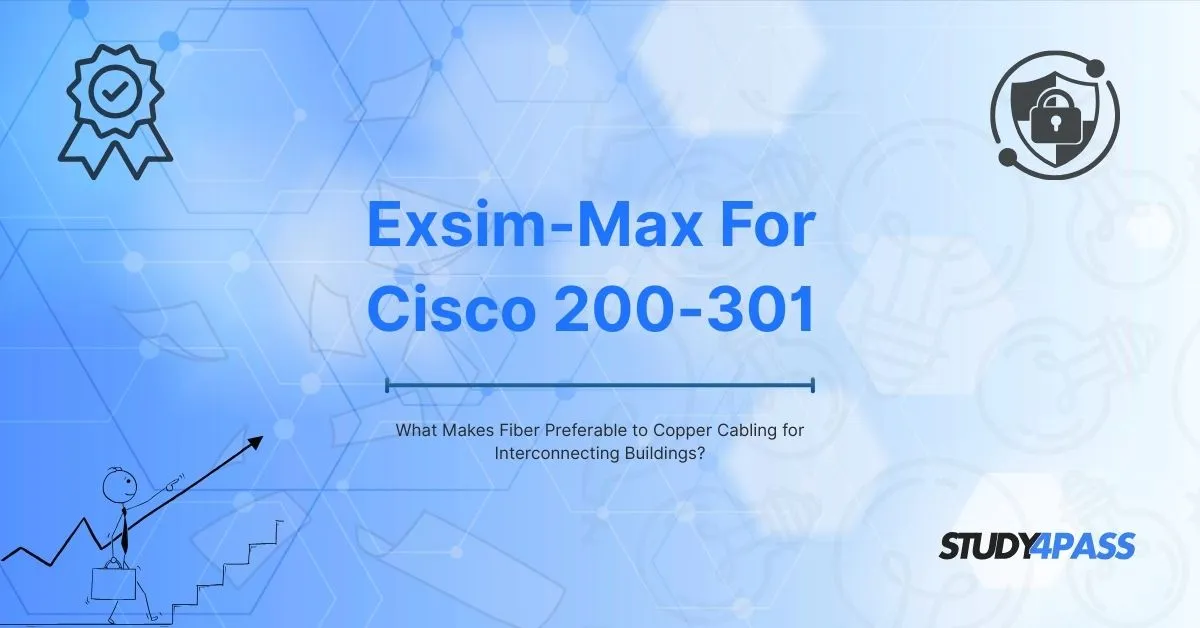Introduction To Exsim-Max For Cisco 200-301
When designing a network that spans multiple buildings, the choice between fiber optic and copper cabling can significantly impact performance. While copper has been the traditional choice for decades, fiber optics offer unparalleled advantages in modern networking environments.
For Cisco CCNA candidates, mastering these differences is key especially when preparing with tools like ExSim-Max Cisco 200-301, which simulates real exam scenarios.
Speed and Bandwidth
Fiber Optic: High-Speed Data Transmission
- Fiber optic cables transmit data using light signals, allowing for significantly higher bandwidth compared to copper.
- Supports speeds of 10 Gbps, 40 Gbps, 100 Gbps, and beyond.
- Ideal for high-demand applications like video streaming, cloud computing, and large data transfers.
Copper Cabling: Limited Bandwidth
- Copper cables rely on electrical signals, which are inherently slower and more susceptible to degradation.
- Typically maxes out at 10 Gbps over short distances (with Cat6a/Cat7).
- Suffers from signal attenuation over longer runs.
- For inter-building connections where speed is critical, fiber is the clear winner.
Distance Limitations
Fiber Optic: Long-Distance Performance
- One of the biggest advantages of fiber is its ability to maintain signal integrity over long distances.
- Single-mode fiber (SMF) can transmit data up to 40 km or more without significant loss.
- Multimode fiber (MMF) supports distances up to 550 meters (for 10 Gbps).
Copper Cabling: Short-Range Limitations
- Copper cables experience signal degradation beyond certain distances:
- Ethernet (Cat6/Cat6a) is limited to 100 meters for optimal performance.
- Beyond this, repeaters or switches are required, increasing cost and complexity.
For campus networks or data centers spread across multiple buildings, fiber eliminates distance-related bottlenecks.
Immunity to Electromagnetic Interference (EMI)
Fiber Optic: No EMI Susceptibility
- Since fiber uses light instead of electricity, it is immune Cisco 200-301 Certification to:
- Electromagnetic Interference (EMI) from power lines, motors, or radio frequencies.
- Crosstalk between adjacent cables.
- This makes fiber ideal for industrial environments or areas with high electrical noise.
Copper Cabling: Vulnerable to EMI
- Copper cables act as antennas, picking up interference from:
- Nearby electrical wiring.
- Radio transmitters.
- Fluorescent lighting.
- Shielding (STP cables) can help but adds cost and complexity.
Security Advantages
Fiber Optic: Difficult to Tap
- Fiber offers enhanced security because:
- It does not emit electromagnetic signals, making eavesdropping extremely difficult.
- Any attempt to physically tap the cable causes noticeable signal loss, alerting administrators.
Copper Cabling: Easier to Intercept
- Copper cables can be tapped using inductive probes, posing security risks in sensitive environments.
- For organizations handling confidential data, fiber provides a more secure solution.
Durability and Environmental Resistance
Fiber Optic: Resistant to Harsh Conditions
Fiber cables are:
- Lightweight and flexible, making installation easier.
- Resistant to moisture, temperature fluctuations, and corrosion.
- Non-flammable, reducing fire hazards.
Copper Cabling: Vulnerable to Environmental Factors
Copper is:
- Heavier and bulkier, complicating installations.
- Prone to corrosion in humid or salty environments.
- Conductive, posing risks in lightning-prone areas.
- For outdoor or underground inter-building links, fiber is far more reliable.
Cost Considerations
Fiber Optic: Higher Initial Cost, Lower Long-Term Expenses
- Upfront costs for fiber cables and transceivers are higher than copper.
- However, lower maintenance, longer lifespan, and reduced signal loss make it cost-effective over time.
Copper Cabling: Cheaper Initially, Higher Maintenance
- Lower initial cost, but higher power consumption (due to signal boosting).
- More frequent replacements and repairs due to wear and interference.
- While budget constraints may favor copper initially, fiber’s long-term benefits justify the investment.
Future-Proofing Networks
- As networks evolve, fiber optic infrastructure ensures scalability:
- Supports emerging technologies like 5G, IoT, and high-speed data centers.
- Easily upgradable without replacing entire cabling systems.
- Copper, on the other hand, is reaching its physical limits, making fiber the smarter choice for future growth.
Conclusion
When interconnecting buildings, fiber optic cabling outperforms copper in speed, distance, security, and reliability. For IT professionals preparing for the Cisco 200-301 exam, understanding these differences is crucial.
Special Discount: Offer Valid For Limited Time “Cisco200-301 Exam”
Sample Questions for Cisco 200-301 Exam Prep Practice Test
What is the primary purpose of the ExSim-Max practice tests for Cisco 200-301?
A) To provide actual exam questions from the CCNA test bank
B) To simulate the real exam environment with high-quality practice questions
C) To replace the need for official Cisco study guides
D) To guarantee a passing score on the CCNA exam


